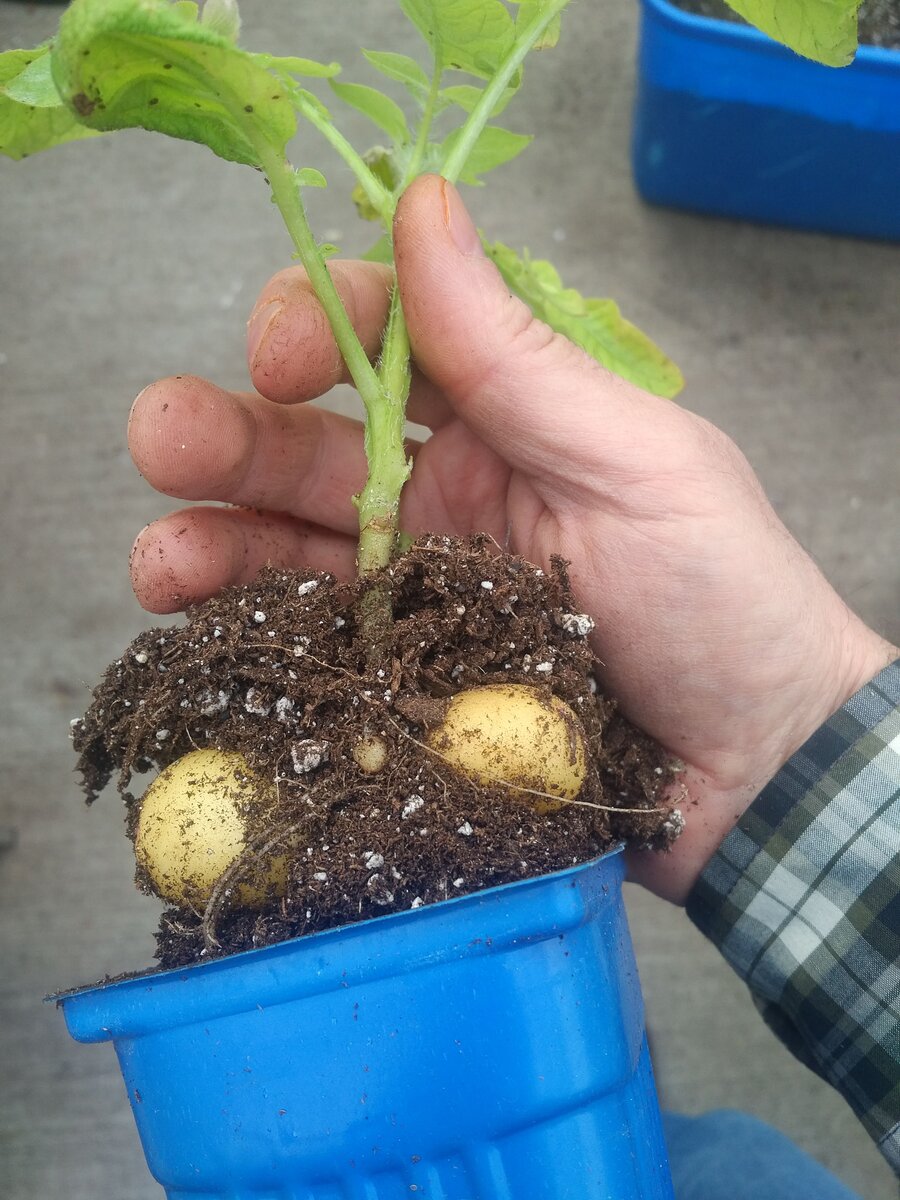Back to January 2024 Newsletter
Create Your Own New Potato Varieties!

Bob Wildfong
If you've ever wanted to grow a plant that literally nobody else grows, or has ever grown, what could be more fun than to breed new varieties of vegetables and flowers? I'm going to show you how to create new varieties of potatoes, from potato seeds. Not seed potatoes, actual seeds. If that sounds strange, you aren't alone. Most gardeners have never seen actual potato seeds, and if they've seen potato fruit they probably didn't know what they were looking at.
Potato fruit? Yes potatoes have fruit.
First, let's take a step back.
How everyone normally grows potatoes
If you've ever grown potatoes, you've probably done the same thing as everyone: you planted small potatoes, or pieces cut from a large potato. They grow roots, then sprouts, and the sprouts grow into plants that produce more potatoes underground. If you think about it, those aren't actually new plants though. They're really just pieces of an older plant that was divided. In fact, if you really think about it, every potato of any particular variety is just a division of an original plant of that variety. That's right, all the Yukon Gold potatoes in the world are just pieces from one single, original plant. That's why they're all the same.
So where do they get new varieties?
If every potato grows an identical copy of the plant that it came from, then where do new potato varieties come from? The same place as every plant: from seeds. There is some confusion about the term "seed potatoes". Those are small tubers or pieces that you can buy to plant potatoes the usual way, but they aren't truly seeds. Seeds come from fruit, which come from flowers, and potatoes have those. We get new potato varieties by planting true potato seeds, which come from the fruit at the top of the plants. If you've never seen them, see the photos below.
Potatoes are heterozygous tetraploids which means they have mixed genetics from their parents, and also they have way more genes than most plants do. What that boils down to is that every seed in a potato fruit will grow into a completely new variety, different than its parents, different from its siblings, and even seeds from the same fruit can have an astonishing diversity of shapes, textures, colours, sizes, and every potato trait that you can think of.
Our favourite potato varieties have actually come to us by people, through the centuries, planting those seeds, growing the plants to maturity, and assessing the assortment of results.
The complete process is shown below, but you can side-step the hardest part - finding the potato berries and saving the seeds - because I've done that for you. Check the Member Seed Exchange for "Potato, True Seeds" and get started with your potato breeding right away!

Potato plants don't always flower, but when they do they look like this.
|

With luck, some flowers pollinate and turn into fruit. This seems to be more successful on some varieties than others. The fruit stay greenish-purple when ripe so it's hard to tell when to harvest them. Wait until they get a little soft, and detach with a very gentle pull. Sometimes they fall off, but they don't get damaged.
|

Potato fruit are like small tomatoes, which makes sense because they're in the same plant family. Don't eat them though - they're poisonous!
|

It's easy to squeeze the seeds out of the berries, and even easier if you do that under a little water. |

A little rinse gets the juice off so they won't stick together. Just be sure to use a very fine mesh because the seeds are very small. Let them dry fully and keep them dry until you plant them. Potato seeds should last for at least a few years in a dry place.
|

Like many plants with tiny seeds, it's best to sow potato seeds indoors where you can control the conditions, avoid weeds, and prevent disturbances that would damage tiny seedlings. |

Every seedling is a new genetically unique plant, completely different from the others, its parents, ancestors, and every other potato plant ever. Which one will you like best? It will take two summers to find out, so plant as many as you can fit for the best assortment.
|

You might choose to grow your potato seedlings in pots for the first whole season. They're really small, and they take a few months to even grow large enough to put in a larger pot like this. They're very easy to grow in pots, tolerant of a range of different temperatures. They like consistent moisture, but the soil should get dry at the surface between watering.
|

After 4-6 months, you might see your seedlings turn yellow, then brown. Don't be alarmed! Potatoes do this in the garden too, when it's time to harvest the potatoes. It's called senescence, and it just means that the plant is shedding its above-ground growth to preserve the important below-ground tubers. Just remember that maple trees do this too!
|

And as your potato seedlings grow, you can check their progress. Once you see little potatoes, wait for the tops to die down, then harvest the mini-tubers. These are now ready for planting outside like "seed potatoes", in their second growing season, except they'll grow into a new variety that nobody has ever seen before. |
--
Bob Wildfong is Seeds of Diversity's Executive Director. He loves potatoes boiled, fried, baked, mashed, scalloped, roasted, and cooked in campfires.
Not yet a member?
An annual membership to Seeds of Diversity gives you access to our seed exchange, seed grow-out programs, and our online news.

We depend on donations to do our work.

Thank you for your support!
